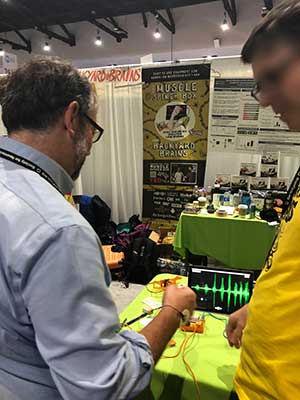Brain Science for Everyone — Including You
By
In honor of Brain Awareness Week, let me ask you a question: when you think of the brain, what do you think of? A blob of grey tissue? A minicomputer packed inside your head? A massive tangle of wires?
The brain is all these things and more.
Most of the time, it takes some pretty sophisticated equipment to learn about the brain, explain its tremendous complexity, and help us make progress in treating brain disorders. Room-size magnetic resonance imaging (MRI) scanners can reveal the overall structure of the brain, with breathtaking images of strange-sounding brain regions like the “cerebral cortex,” “amygdala,” and “hippocampus.” Sophisticated electronic hardware can monitor the myriad electrical signals generated by the billions of neurons in our brains and translate those signals into electroencephalogram (EEG) traces, which can tell us whether a patient might be having a seizure. Delicate micro wires implanted deep within the brain, capable of stimulating just a handful of the trillions of connections between these billions of neurons, can be used to treat diseases like Parkinson’s and major depression.
These and other impressive technologies have opened the black box (or, if you prefer, the grey blob) that is the brain and taught us a ton (or at least 3 lbs, the average weight of an adult human brain) about its inner workings. However, we still have a long way to go to fully understand it.
At NIMH, we are excited by the ground-breaking science we can accomplish with these technologies. But Brain Awareness Week is about getting everyone involved in neuroscience. And there’s a surprising amount you can learn about your brain without complicated tools and technology. Are you interested in neuroanatomy? Check out this free “Get Excited about the Brain” coloring book. Want to learn how the brain responds to stress (and how to deal with it)? Take a look at this video on “Getting to Know Your Brain.” These and more materials can be found on NIMH’s website, where we have a whole section on educating yourself and others about the brain.

If you’re a bit more ambitious or have a classroom of students to work with, you can try several neuroscience experiments with a do-it-yourself kit or two. An NIMH small business award grantee, Backyard Brains, has developed a bunch of fun kits. You can record your muscle activity and even use it to move your friend’s fingers. Like magic, only it’s real—and really fun. Here I am at their display at a neuroscience conference—the green trace on the screen behind me is my very own muscle activity!
You can also try some cool experiments with little or no equipment. One of my favorites requires a waterfall. If you’re on a hike and you come across a waterfall, try this while holding on to a buddy (why hold on to someone? You’ll see in a minute). Stare straight at the waterfall without moving your eyes for a minute or two. You should be close enough to the waterfall that it fills up a good chunk of what you can see. After a minute passes, look away toward something stationary, like some rocks or a tree. Whatever you are looking at will seem to be moving upwards! (That’s why you’re holding on to something—the feeling of movement can be so strong that you may feel a bit dizzy for a moment, especially if the waterfall took up your entire field of view).
What does this have to do with the brain? Well, inside your brain are many visually sensitive neurons, including groups of specialized neurons that detect motion in each and every direction. When you watch something that is not moving, the neurons that detect upward movement and those that detect downward movement have just about the same activity. But watching a waterfall activates the neurons that detect downward motion, and after a while, these neurons get used to the waterfall, and their activity begins to slow down. Take away the waterfall movement suddenly, and the downward neurons shut off completely while neurons that detect upward motion kick back into action. This makes your brain think that there is something out there in the world moving upwards.
From this experiment, scientists learned that there are opposing channels in the brain that detect opposite motion (and color and all sorts of other visual phenomena) and that these channels adapt from moment to moment. Investigating relatively simple effects like the waterfall illusion has taught scientists a lot about how the brain works.
The waterfall illusion also shows that it is not only scientists who can do experiments that tell us about the brain. So, this Brain Awareness Week, I encourage you to dive in and learn more about your brain, wherever you are—your backyard, kitchen table, classroom, or even on a hiking trail near a waterfall!

